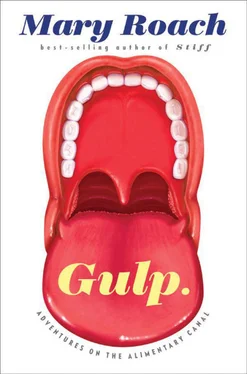John Gray lifts his head and says, in his quiet way, “I’ve got a dead leopard frog in the freezer.”
Everyone takes a break while Gray goes to defrost his frog under a warm tap. Walt entertains us with talk of an alternative-medicine experiment going on at the medical school—healers practicing Reiki on mice. Tracy walks next door to get a toad to show me, a new species he discovered doing fieldwork in Argentina. He returns with it in a glass dish, cradled against his belly. He looks like a kid standing in the kitchen with his cereal bowl. It’s a nice toad, less warty than some. I tell him this, and he seems pleased. “You could be the first person to like this species.” Second, I’m pretty sure.
“You could be the last too,” says Lee, more of a frog guy.
Gray rejoins the group with the defrosted leopard frog, now pinned in a dissecting tray. Lee snips up the midline of the belly and peels back the flaps of skin as if they were stage curtains. Professor Tracy slides a superworm into the stomach.
The 1925 essay “The Psychology of Animals Swallowed Alive” opens with the author sitting “in quiet contemplation digesting after dinner” and wondering whether animals that swallow their prey live [61] Those of you who swallow oysters without chewing them may be curious as to the fate of your appetizers. Mollusk scientist Steve Geiger surmised that a cleanly shucked oyster could likely survive a matter of minutes inside the stomach. Oysters can “switch over to anaerobic” and get by without oxygen, but the temperature in a stomach is far too warm. I asked Geiger, who works for the Florida Fish and Wildlife Research Institute, about the oyster’s emotional state during its final moments inside a person. He replied that the oyster, from his understanding, is “pretty low on the scale.” While a scallop, by comparison, has eyes and a primitive neural network at its disposal, the adult oyster makes do with a few ganglia. And mercifully, it is likely to go into shock almost immediately because of the low pH of the stomach. Researchers who need to sedate crustaceans use seltzer water because of its low pH. Geiger imagined it would have a similar effect on bivalves. But you might like to chew them nonetheless, because they’re tastier that way.
are “worried by the acrobatic effects of victims trying to escape.” If this leopard frog were alive, if frogs have the neurological wherewithal to worry, then the answer must be yes, they sometimes worry. The mealworm, with obvious worries of its own, animates the frog stomach like a sock puppet, arcing and straightening and squirming in the snug pink sac for fifty-five seconds. Then it stops completely. “Blanket effect,” says someone.
The superworm is extracted and set aside. Like the others, it is motionless but not dead. And as with all the earlier entrées, this one will wake up after half an hour or so outside the stomach and appear to be fully recovered. A second worm is left in place overnight, to rule out the possibility that superworms can shrug off the blanket effect and resume their efforts to escape. It is dead by morning. “There is no way in my mind that they can eat their way out of stomachs,” states Tracy.
Walt is not as sure. He was impressed by the vigor of the superworm’s struggle. “What if there were a weak spot in the stomach?” Might it be possible to escape a stomach by rupturing it with an especially forceful squirm?
That appears to be what was depicted in a photograph that went viral in 2005, of a dead python in a Florida swamp with the tail and hind legs of an alligator sticking out of its side.
“That’s what everyone was saying: that the alligator kicked its way out,” Stephen Secor told me. Secor had been flown out to the scene by a National Geographic television production team, who had hired him as an on-camera expert for a one-hour special spawned by the chimerical remains. Secor knew before he arrived that the dinner-kicking-its-way-out scenario was extremely unlikely. Pythons kill their prey before eating it. [62] How remains a matter of debate. I had heard that pythons suffocate prey by tightening on its exhale and preventing further inhales. Secor says no; prey passes out too quickly for that to be the explanation. “You’d still have oxygen circulating in the blood, like you’re holding your breath.” He thinks it’s more likely that the constriction shuts off blood flow, more like strangulation than suffocation. An experiment was planned at UCLA but nixed by the animal care committee. Secor would volunteer himself. “I think we’d all like to have a giant snake constrict us in a controlled situation and see what happens—could we still inhale?” It’s possible he’s a little nuts. But in a good way.
“And there’s no way stuff can move once it’s inside there.”
There was in fact a weak spot. Secor pointed to a printout of the photograph I’d brought with me when I visited his lab in late 2010. Two-thirds of the way down the python’s exterior is a patch of black (dead) tissue—a poorly healed wound from some earlier incident. The rupture of this wound, Secor thinks, was caused by an alligator, let’s call him alligator B, who attacked the python while he was digesting alligator A. The python broke open at the poorly healed wound, and A popped out. So it wasn’t, at the end of the day, a case of dinner exacting revenge from within. Just another dog-eat-dog day in the Everglades.
THE OTHER THEORY Stephen Secor debunked for the National Geographic program was that the alligator dinner was so enormous the python simply burst. “That,” he said, pointing to the meal in the famous photograph, “is nothing.” The python is built to accommodate prey many times wider and bulkier than itself. The esophagus is a thin, pink stretchable membrane, a biological bubble gum. Secor went over to his computer and pulled up a slide of a python engulfing the head, neck, and shoulders of an adult kangaroo. This was followed by a shot of a python with three-quarters of a gazelle “down in,” with only the hips and rear legs remaining al fresco. Pythons use their muscular coils to pull the prey apart, like taffy, so it’s narrower and easier to get down. And they don’t swallow in a single peristaltic wave of muscle contraction, as we do. They do what’s called a “ptergoid walk.” They inch their jaws along on the prey like marines on their bellies, moving forward by the elbows, left, right, left.
The other reason Secor could dismiss the bursting-stomach theory is that he knows exactly how much pressure that would take. “We sealed off the cloaca of a dead python and inserted an air line down the esophagus.” Probably much like you at this moment, Secor was “sick of listening to people talk about pythons bursting.” I would give you the citation for his experiment, but Secor did not publish a paper. It was “just a fun thing.” He pointed to my printout of the python-alligator photo. “It was a lot more pressure than could be generated from this.”
Biologists have a term for stretchy, accommodating digestive equipment: compliant. You’re planning on taking down an ibex? Yes. No problem. I can handle it. The compliant stomach is a physiological larder, a storage unit for the food that will sustain an animal over the days or weeks when prey are scarce or it’s off its game. It is the stomach of feast-or-famine. “The predator has a very compliant stomach,” says David Metz, a gastroenterologist with the Hospital of the University of Pennsylvania who has studied people who compete in eating contests. “Think of the lion after the big meal, with its huge, distended belly. They can lie in the sun for the next few days, letting it all slowly get digested.” When you occupy the top spot on the food chain, you are free to lounge around with little concern over someone larger and stronger jumping you and eating you. The lion falls prey only to humans, in the form of hunters—and the occasional Mesopotamian vivisectionist.
Читать дальше












